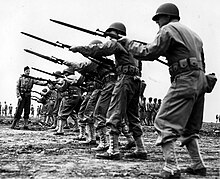Camp Peary
This article needs additional citations for verification. (March 2011) |
| AFETA CAMP PEARY | |||||||
|---|---|---|---|---|---|---|---|
AMSL | |||||||
| |||||||
| Source: Federal Aviation Administration[1] | |||||||
Camp Peary is an approximately 9,000 acre U.S. military reservation in
Camp Peary is named for Arctic explorer Rear Admiral
Location
Comprising 9,275 acres (37.53 km2) of land, of which about 8,000 acres (32 km2) are unimproved or only partially improved. The 100 acres (40 hm2) Biglers Millpond occupies the site adjacent to the York River.
The majority of Camp Peary falls within York County, though a small portion of the reservation near Skimino Creek at the western edge is located in James City County.
World War II, relocations of residents

During
Seabee training

At the outset of the War, the preliminary training of the Seabees had been carried out at Naval Training Stations across the country. That lasted a short period until boot training was consolidated at Camp Allen Virginia.
Base commander Capt. J.G. Ware had the idea to raise hogs on base so the recruits called the place Capt. Wares hog farm. Originally the hog yard was in the center of the camp, but the enlisted complained that the pigs were on high ground while they were in the mud. This got the hogs moved to a more obscure location, but still within the limits of the military reservation. A bulldozer was used for clearing the feed troughs and transporting slop from the galley to the hog yard.[7] Eventually the farming enterprise made the news and it is from this history that base derives "The Farm" moniker used today.
German prisoners-of-war
Camp Peary's mission changed when a new need presented itself to the Navy. A portion of the land became a detention center for
Many of the former POWs stayed in Virginia and the United States after the war, and became naturalized as U.S. citizens.
Post-World War II use
Vacated by the Navy in 1946, Camp Peary became a Virginia state forestry and game reserve for five years. A reservoir that had been built on the upper reaches of Queen's Creek to supply the substantial fresh water needs of Camp Peary when it was a Seabee base was divested to the City of Williamsburg. The Waller Mill Reservoir formed the basis for the city's Waller Mill Park, although the park is located north of the city limits in York County. A portion of the abandoned Chesapeake and Ohio Railway spur from the Peninsula Extension main line just east of near Ewell Station to the base (also built during World War II) is now a recreational rail trail.
Then, in 1951, the U.S. Navy returned to the property, securing the portion north of the highway, which was State Route 168 at the time, and announced it closed to the public; it has been that way ever since. In June 1961, two months after the
The Farm
Camp Peary is known as "The Farm", a training facility run by the
Former CIA officer Bill Wagner attended a three-week interrogation course at The Farm in 1970. He claims it was the agency's "premier course", and that volunteers played the role of interrogation subjects in order to be guaranteed seats in future classes. Interrogators-in-training practiced techniques such as sleep deprivation, deliberately tainted food, and mock executions. According to Wagner, the course was dropped from the CIA training curriculum after the Watergate scandal, due to increased attention being paid to CIA practices.[9]
See also
- Agent handling
- CIA University
- Harvey Point
- Quantico (season 2)
- The Recruit
- Sherman Kent School for Intelligence Analysis
- Special Activities Center
- United States Army Intelligence Center
- Warrenton Training Center
Bibliography
- ISBN 9780399152399.
- Waters, T. J (2007). Class 11: My Story Inside the CIA's First Post-9/11 Spy Class. ISBN 9780452288713.
- ISBN 9780446581738.
References
- PDF, retrieved 2022-02-09
- ^ Miller, Greg (December 1, 2012). "DIA sending hundreds more spies overseas". The Washington Post.
- ^ Walker, Julian (July 27, 2009). "What's in a name? | Camp Peary, near Williamsburg". The Virginian-Pilot. Norfolk, Virginia. Retrieved June 3, 2019.
- ^ This week in Seabee History, Seabee Online Magazine, Naval Facilities Engineering Command (NAVFAC) Attn: SEABEE Online, 1322 Patterson Ave., S.E., Bldg. 33, Suite 1000, Washington Navy Yard, DC 20374-5065[1]
- ^ a b U.S. Navy Seabee Museum facebook, Camp Peary, April 26, 2018 [2]
- ^ "Naval Combat Demolitions Units". SpecWarNet.net. Retrieved October 18, 2017.
- St. Petersburg Times. June 14, 1943.
- ^ Shane, Scott; Grey, Stephen; Williams, Margot (May 31, 2005). "C.I.A. Expanding Terror Battle Under Guise of Charter Flights". The New York Times.
- ISBN 0-87113-876-X.
External links
- "Camp Perry". SourceWatch. Center for Media and Democracy.
- Diamond, John (December 22, 2004). "Ex-spy says CIA trapped in Cold War mode". USA Today.
- Erickson, Mark St. John (December 3, 2017). "Training the Fighting SeaBees of WWII at Camp Peary". Daily Press. Newport News, Virginia. Archived from the original on August 5, 2018. Retrieved January 9, 2018.

